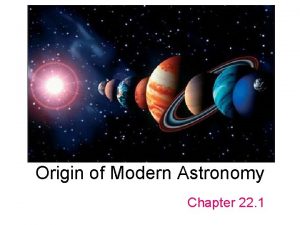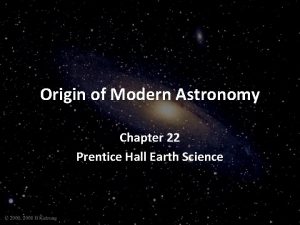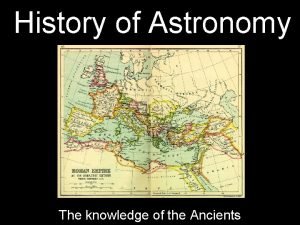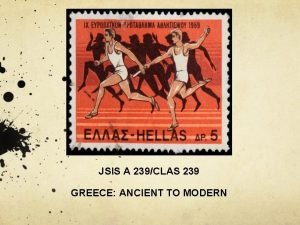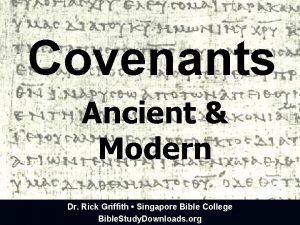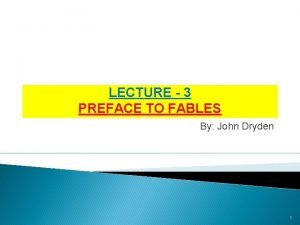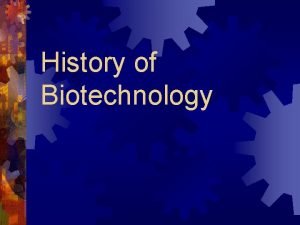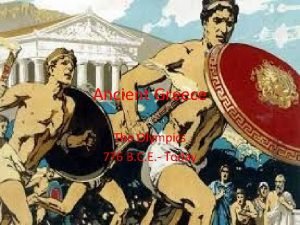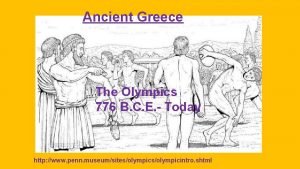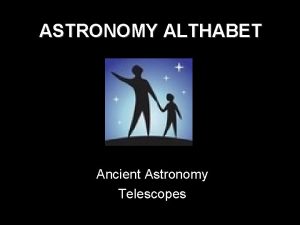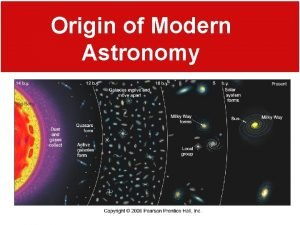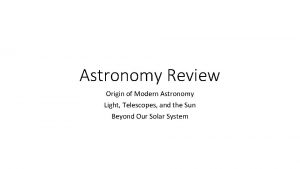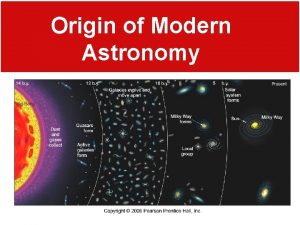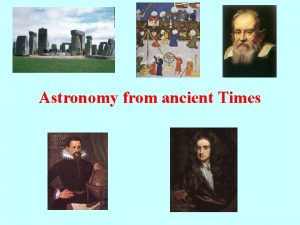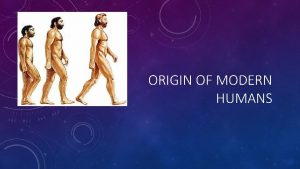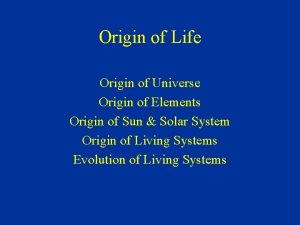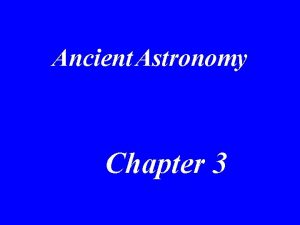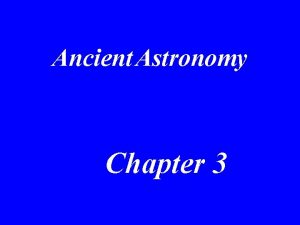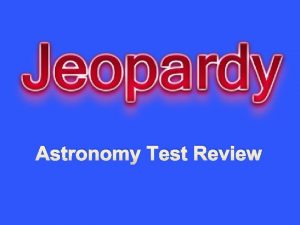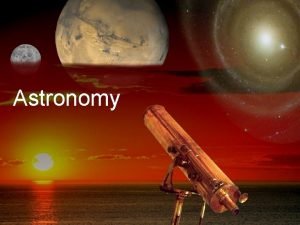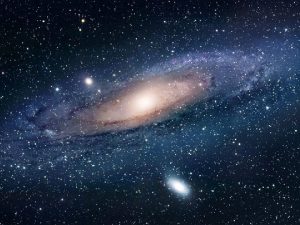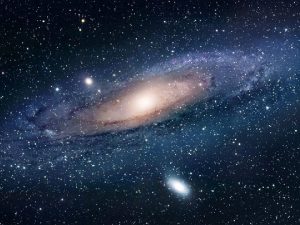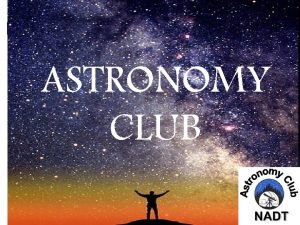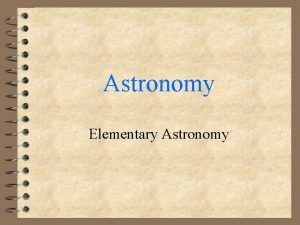Chapter 4 The Origin of Modern Astronomy Ancient





























- Slides: 29

Chapter 4: The Origin of Modern Astronomy

Ancient Greek Astronomy古希腊天文 • Models were generally wrong because they were based on wrong “first principles”, believed to be “obvious” and not questioned: (所依据的“根本原理”是错误而 不可质疑的,因而模型也是错误的。) 1. Geocentric Universe(地心宇宙): Earth at the Center of the Universe. 2. “Perfect Heavens”(完美的天空): Motions of all celestial bodies described by motions involving objects of “perfect” shape, i. e. , spheres or circles. 天体及其运动是完美的球型或圆。

Ancient Greek Astronomers Aristotle 亚里士多德 (384 – 322 B. C. ), major authority of philosophy until the late middle ages: Universe can be divided in 2 parts: (宇宙分成两部分) 1. Imperfect, changeable Earth (不完美的,可变的地球), 2. Perfect Heavens (described by spheres)(完美的天空;球对称)

Issues of Ancient Astronomy (I) 古天文的�� Fundamental argument for the geocentric universe 地心宇宙的依据: Motion of Earth should result in an observable parallax, which was not seen. 如果地球运动,应该有视差,但没看到。

Issues of Ancient Astronomy (II) 古天文的�� The retrograde 退行 (westward) motion of the planets 行星相对于背景星空(天球)退行的现象 The “solution”: Epicycles! “解决办法”:本轮

Introduced by Ptolemy 托勒密 (ca. A. D. 140) The Ptolemaic system was considered the “standard model” of the universe until the Copernican Revolution. 在哥白尼革命之前,托勒密系统一直是标准模型

The Copernican Revolution 哥白尼革命 Nicolaus Copernicus (1473 – 1543): heliocentric universe 日心宇宙 (sun in the center)



Tycho Brahe第谷·布拉赫 (1546 – 1601) Use of high-precision instruments for precise astronomical observations, reported in tables. 利用精密仪器的精确的天文观测的开端 Later used by Kepler 开普勒 to develop laws of planetary motion. 后来,开普勒利用这些数据找到了行星运动规律

A Quadrant designed by Brahe Used to precisely measure an object’s angular distance above the horizon 精确测量天体距 地平线的角度。


Kepler’s Laws of Planetary Motion 开普勒行星运动定律 1. The orbits of the planets are ellipses with the sun at one focus (轨道是椭圆,太阳在一个焦点上。) c e = c/a e的大小在 0和1之间 Eccentricity椭率

Eccentricities of Ellipses 1) 椭圆的椭率 2) e = 0. 02 3) e = 0. 1 e = 0. 2 5) 4) e = 0. 4 e = 0. 6





Major discoveries of Galileo (I): 伽利略的主要发现 • Moons of Jupiter 木星的卫星 (4 Galilean moons) • Rings of Saturn土星环 (What he really saw)

Major discoveries of Galileo (II): 伽利略的主要发现 • sunspots 太阳黑子 (proving that the sun is not perfect!) 证明太阳不是完美的!

Major discoveries of Galileo (III): 伽利略的主要�� • Phases of Venus (including “full Venus”), proving that Venus orbits the sun, not Earth! 观测到金星位相,证明金星绕太阳,而不是地球。

Historical Overview

Isaac Newton牛顿 (1643 - 1727) • Building on the results of Galileo and Kepler • Adding physics interpretations to the mathematical descriptions of astronomy by Copernicus, Galileo and Kepler Major achievements: 1. Invented calculus微积分 as a necessary tool to solve mathematical problems related to motion 2. Discovered the three laws of motion运动定律 3. Discovered the universal law of mutual gravitation引力

The Universal Law of Gravity 万有引力 • Any two bodies are attracting each other through gravitation, with a force proportional to the product of their masses and inversely proportional to the square of their distance: F=-G Mm r 2 (G is the gravitational constant 引力常数. )

Understanding Orbital Motion The universal law of gravity allows us to understand orbital motion of planets and moons: Example: • Earth and moon attract each other through gravitation. Dv v • Since Earth is much more massive than Moon the moon , the moon’s effect on Earth is small. F • Earth’s gravitational force constantly Earth accelerates the moon towards Earth. • This acceleration is constantly changing the moon’s direction of motion, holding it on its almost circular orbit. v’

Orbital Motion (II) In order to stay on a closed orbit, an object has to be within a certain range of velocities: 在闭合轨道上运动,物体运动必 须在一定的速度范围内。 Too slow : Object falls back down to Earth Too fast : Object escapes the Earth’s gravity



 Origin of modern astronomy
Origin of modern astronomy Chapter 22.2 origin of modern astronomy answer key
Chapter 22.2 origin of modern astronomy answer key Learning astronomy by doing astronomy activity 1 answers
Learning astronomy by doing astronomy activity 1 answers Learning astronomy by doing astronomy activity 7 answers
Learning astronomy by doing astronomy activity 7 answers Learning astronomy by doing astronomy activity 1 answers
Learning astronomy by doing astronomy activity 1 answers Astronomy in ancient rome
Astronomy in ancient rome Ancient communication devices
Ancient communication devices Ancient india vs ancient china
Ancient india vs ancient china Meaning of the fearful passage of their death-marked love
Meaning of the fearful passage of their death-marked love Modern names
Modern names Ancient modern bible
Ancient modern bible Preface to fables ancient and modern summary
Preface to fables ancient and modern summary Ancient olympics vs modern olympics
Ancient olympics vs modern olympics Stages of biotechnology
Stages of biotechnology Ancient olympics vs modern olympics venn diagram
Ancient olympics vs modern olympics venn diagram 776 b.c.e
776 b.c.e Hình ảnh bộ gõ cơ thể búng tay
Hình ảnh bộ gõ cơ thể búng tay Lp html
Lp html Bổ thể
Bổ thể Tỉ lệ cơ thể trẻ em
Tỉ lệ cơ thể trẻ em Chó sói
Chó sói Glasgow thang điểm
Glasgow thang điểm Hát lên người ơi alleluia
Hát lên người ơi alleluia Các môn thể thao bắt đầu bằng tiếng chạy
Các môn thể thao bắt đầu bằng tiếng chạy Thế nào là hệ số cao nhất
Thế nào là hệ số cao nhất Các châu lục và đại dương trên thế giới
Các châu lục và đại dương trên thế giới Công thức tiính động năng
Công thức tiính động năng Trời xanh đây là của chúng ta thể thơ
Trời xanh đây là của chúng ta thể thơ Mật thư tọa độ 5x5
Mật thư tọa độ 5x5 Phép trừ bù
Phép trừ bù
